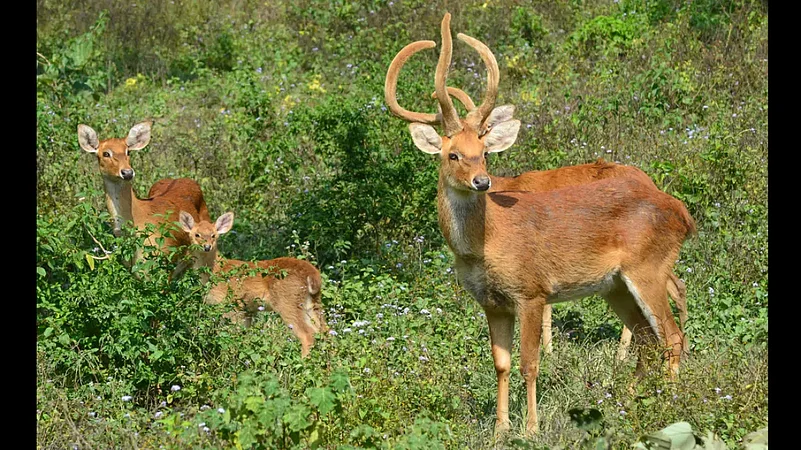A COMMUNITY EFFORT IN EAST KEMANG
Even after Pakke Tiger Reserve, in East Kemang, Arunachal Pradesh, was declared a reserve for its tiger population and diversity of its flora and fauna in 2002, poaching continued unchecked. Then came perhaps the most sophisticated collaboration between a local community and the forest department. Sixteen gaon burahs (village chiefs) of the Nyishi tribals passed a resolution that acknowledged a list of wildlife violations and encouraged conservation. The villagers followed them like commandments, and Pakke became a blessing to its biodiversity. Indeed, a hotspot with 2,000 plant species, 300 bird species (including four hornbill species, whose conservation earned the Reserve an Indian Biodiversity Award in 2016, and the endangered white-winged wood duck), 40 species of mammals (including the clouded leopard, wild dog and elephant), and many amphibians, reptiles and insects, the place continues to thrive with local collaborative efforts. For instance, Pakke Jungle Camp is run by the local self-help conservation group Ghora-Aabhe and Help Tourism. Community owned and meant to help conserve wildlife, the camp has four comfortable cottages built on stilts by local artisans using eco-friendly material. You may even spot elephants beyond its boundaries, though fences will prevent them from sauntering inside. Visitors here can enjoy local food, guided safaris and nature walks, and cultural experiences. It is best to visit between February 24 and 27, when the Nyishi’s Nyokum Yullo, or harvest festival, is celebrated.
THE DANCING DEERS OF MANIPUR
Located around 48km from Imphal, in the Bishnupur district of Manipur is the Keibul Lamjao National Park which is home to the brow-antlered deer (sangai). The southeastern part of the Loktak Lake falls within the park, which comprises 40 sq km of wetland featuring floating biomass. These floating meadows are called phumdi in Manipuri. The phumdi are a natural habitat for the sangai, Manipur’s state animal. They are also the reason these creatures are fondly called dancing deer. The wobble in the deer’s gait as it treads the soft, floating mass of vegetation (sometimes up to 1.5m deep) makes it seem like it is putting on a strut show. A small herd of just 14 dancing deer were reported to exist in 1975. But as conservation action was undertaken and the region declared a national park in 1977, the population blossomed over the years. In 1995, 152 sangai were reported and a 2016 census put the number at 260. The park is also home to the hog deer, sambar, muntjac, wild boar, large Indian civet cat and common otter, besides a variety of fishes, amphibians and birds, including the black eagle, waterfowl and many types of hornbills.
DAMSELS AND DRAGONS IN RAIGAD
We speak not of a fairy tale here but the Karnala Bird Sanctuary in Raigad, Maharashtra. Other than sightings of birds such as the rare ashy minivet or the vibrant Malabar trogon, prepare to find dragonflies and damselflies of all kinds and colours soaring by the canopies. You might even spot the majestic crimson marsh glider hopping along a pond or the wandering glider in its splendid shade of yellow perched on a bark by the pond side. Other dragonfly species include the ditch jewel, ground skimmer, black forest skimmer, fulvous forest skimmer, common clubtail, blue-eyed darner and lesser green emperor. Damselflies, smaller than dragonflies but with the ability to fold their wings when they’re at rest, are represented by the three-lined blue dart, black bambootail and pygmy dartlet. These insects help maintain Karnala’s food chain, and their flights, sometimes 60kmph and faster, are gape worthy. They also eat mosquitoes, and that makes them your greatest friends. Best time to visit is October and November; else, look out for the Bombay Natural History Society’s next guided walk (bnhs.org).
DOLPHIN TALES IN BHAGALPUR

The South Asian river dolphin is an endangered freshwater dolphin. Its subspecies, the Ganges river dolphin, can be spotted in various Ganga distribution ranges across the subcontinent, though the numbers have dwindled over the decades. Be it in Bihar, Madhya Pradesh or Assam, one has to be lucky to spot the elusive dolphins who happen to be blind. In the Vikramshila Gangetic Dolphin Sanctuary located in Bhagalpur, the country’s only sanctuary for these mammals, one can soon take an hour-long boat ride to spot these beautiful creatures. The boat ride is an effort by of the state’s environment and forest department to increase eco-tourism facilities and is reported to start operations from October. Recent reports suggest that the sanctuary has over 300 dolphins, apart from turtles, gharials and other animals. National Chambal Sanctuary in north India and Dibru-Saikhowa National Park in Assam are also fine places to spot these dolphins. Diphlu River Lodge, near Kaziranga National Park, offers guests a dolphin boat safari down the Brahmaputra. Apart from the mammal, one can also spot various avian species on this safari.
SPOTTING THE ELUSIVE MARTEN OF THE NILGIRIS
Have you heard of the Nilgiri marten? Probably not. The rare, small and insufficiently studied mustelid is believed to have a population of only about 1,000. If you find yourself at Pampadum Shola National Park in Kerala’s Idukki district, there is a possibility of running into these little creatures since they are endemic to the region. The Nilgiri marten is about 50 to 70cm long, dark brown in colour with a lemon-yellow patch on its throat, making the carnivorous mammal very distinct. The shola grasslands and temperate forests make it the ideal habitat for the marten, which belongs to the same family as the weasel and badger. While scholars suggest the Nilgiri marten is active throughout the day, its peak time is 9 to 11am and 3 to 5pm. However, the black wattle plant that was introduced in the shola grasslands about 30 years ago has become a threat to these mammals today. The plant diminishes the quality of the grasslands. While there are no tours on offer, do try and take a picture of the mammal if you spot it in the wild because, according to studies, their encounters with humans have been brief.
UP CLOSE WITH DUGONGS IN KUTCH
With only about 250 remaining in Indian waters, dugongs are difficult to spot and not very well known. They prefer warm climates and shallow waters, restricting their habitat along East Africa to Australia. Dubbed 'sea cows', these creatures spend most of their time chomping on underwater grass. They are big with thick grey skin, scant hair and long snouts. Like whales and dolphins, they frequently come up for air. Their tails with flukes and their dorsal fins resemble those of a whale and shark, respectively. Dugongs are harmless as they are defenceless, putting them at risk from poachers who hunt them for meat and oil. The coastal areas of the Gulf of Kutch, Gulf of Mannar and the Andaman Islands make for preferable grazing grounds for these docile creatures. Though a marine animal, the dugong shares its ancestors with other terrestrial herbivores like the elephant and hyraxe. Dugongs can be spotted in the marine sanctuaries of Kutch, Mannar and Andaman and Nicobar Islands. In Mahatma Gandhi Marine National Park in Wandoor in the Andamans, you can opt for the snorkelling tour to try and catch a glimpse of the shy creature.
EXPLORE MARINE LIFE IN MUMBAI
When it comes to looking for a wildlife experience, we often think of dense forests or deep oceans, far removed from the cities we dwell in, forgetting the constantly-adapting wildlife that exists in urban spaces as we continue to encroach on their natural habitats. In an effort to help people shed this perception, Marine Life of Mumbai organises walks along the city’s shorelines to experience the plethora of marine life. They help you look beyond the muck on the beaches and find corals, aquatic plants and diverse marine life. Keep a lookout for starfish, hermit crabs, clams, squids, sea cucumbers, slender giant moray eels, blue swimming crabs and white-spotted whiprays, among others on a trail. If you are lucky, you could even spot an octopus or two. Marine Life of Mumbai’s organises walks and events regularly. Find out more here..





















